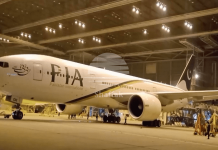ISLAMABAD: The China-Pakistan Economic Corridor (CPEC) has transformed the ICT landscape beyond expectation, fostering a thriving digital economy, creating lots of job opportunities, uplifting the local communities, attracting investment and shortening distances.
The ICT projects – launched under this multibillion-dollar project – particularly helped fight off the challenges during the COVID-19 pandemic in 2019 that dealt a deadly blow to the country’s fragile economy, leading to the closure of scores of both big and small businesses and rendering hundreds of thousands of people jobless.
During this challenging period, people confined or quarantined to their homes launched their own projects and marketed their products and services in different sectors through the digital inclusion that was made possible only because of these projects.
Projects under CPEC
Cross-Border Optical Fibre Cable:
Costing $44 million, this 820Km project has paved the way for the construction of IT parks, improved the internet outreach and performance, and provided safe and secure communication networks. It was launched in March 2016 and successfully completed in June 2018.
The project reduced distances, catalysed digital connectivity and entrepreneurship, revolutionized online education, facilitated efficient trade, and promoted bilateral cultural collaboration.
Additionally, the project has increased the business opportunities for entrepreneurs and enterprises by reducing the cost of internet services.
The cable enters Gilgit-Baltistan (GB) through the Khunjerab border and runs all along from Mansehra district in KP to Muzaffarabad and onward to Islamabad and Rawalpindi where it docks with the existing optical connectivity network.
The project will also digitally connect Pakistan with several Belt and Road countries, including countries in Central Asia and Europe. It will also provide a more safe and secure path for the internet traffic.
To address Pakistan’s reliance on a single landing station in Karachi, an alternative landing station for the submarine cable is planned to be set up at the Gwadar Port under the CPEC. This will help reduce dependence on the existing submarine cable routes and provide a more secure and reliable international communication network.
The Special Communication Organisation (SCO) recently upgraded the existing network and launched 3G/4G services in the Northern Areas (GB and AJK), which will further strengthen the country’s broadband connectivity.
The availability of 3G/4G services in remote areas is not only providing an easy access to the internet but also generating employment opportunities for the local youth, especially women, and boosting tourism in areas where transportation is difficult without broadband technology.
As per the Pakistan Telecommunication Authority (PTA), the number of 3G and 4G users in the country reached 124.16 million by the end of February 2023.
The project has greatly increased the number of broadband internet users in Pakistan, which currently ranks 89th in the World Economic Forum Networked Readiness Index.
According to former federal secretary of IT and Telecommunication Shoaib Ahmad Siddiqui, the ICT sector’s inclusion into the CPEC framework is leading to the development of a range of technologies such as technology parks, manufacturing plants, artificial intelligence (AI), automation, robotics, cloud computing, and e-governance.
Digital Terrestrial Multimedia Broadcast (DTMB)
The DTMB pilot project was launched at the Rebroadcast Station (RBS) in Murree, Rawalpindi, with a cost of $4 million and has significantly enhanced cultural collaboration between the two countries and stimulated the tourism industry. It was successfully completed in April 2015.
The project enables high-definition broadcasting for digital TV, creating revenue opportunities for the media industry and promoting cultural exchange programs at a higher resolution between China and Pakistan.
Pak-China Science, Technology, Commerce and Logistic Park
In Feb 2016, an agreement was reached to create the ‘Pak-China Science, Technology, Commerce and Logistic Park’ near Islamabad. The park, spanning 500 hectares, is expected to cost $1.5 billion over a period of 10 years, with all the funding coming from China.
Hassan Daud Butt, former project director of CPEC at the Ministry of Planning, Development and Special Initiatives, said digitalisation of CPEC would provide a platform for Pakistan’s software companies to collaborate with Chinese manufacturers, leading to mutual benefits.
He said CPEC offers Pakistan an opportunity to attract foreign investment and become a hub for transhipment and interconnection in the region.
“IT development can revolutionise our agriculture, marketing, tourism, and transportation sectors by modernising and enhancing productivity. It can also address problems related to the intellectual property rights, privacy, protection, affordability and access to information,” said Hassan.
“A rapid and extensive communication network will enable Pakistan’s private technology sector, particularly small and medium enterprises, to develop business relationships with their counterparts in China and other countries.
“The markets that Pakistan will have access to through these projects extend beyond Asia to Europe and Africa, creating unlimited opportunities for manufacturing, products, services, and resources”.
Owing to multiple strategic, development, and trade compulsions, China and Pakistan are especially focusing on the development of the IT sector for CPEC and beyond.
Federal Minister for IT and Telecommunication Syed Aminul Haque has said that the launch of 5G technology in Pakistan will help address the challenges of the digital world.
The minister said that providing broadband services across the country is a top priority of the IT ministry and urged the telecom sector to upgrade their infrastructure to ensure quality services for the masses. He said upgrading infrastructure is essential for improving the quality of telecom services.
Thanks to the CPEC-led cooperation, the total value of Pakistan’s IT industry is predicted to reach $10 billion by 2025. Pakistan has more than 2,000 software research and development centres and presently it is the fourth largest base for free IT practitioners in the world.
President Arif Alvi recently said that Pakistan’s information technology sector has the potential to increase its exports to $50 billion.
Data available with WealthPK shows that Pakistan’s IT and IT-enabled services export remittances declined by 0.46% during the first nine months of the current fiscal year 2022-23, standing at $1.941 billion compared to $1.950 billion during the same period of the previous fiscal year.
DTMB-A (Digitalisation of three sites of PTV)
The Pakistan Television (PTV) has initiated a project to digitalise its three sites in Murree, Cherat, and Kala Shah Kaku with an estimated cost of Rs3.8 billion. The project, known as inline project DTMB-A, aims to upgrade the technology infrastructure of the sites to meet modern digital requirements. –Agencies





